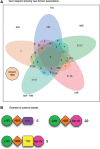PRGdb: a bioinformatics platform for plant resistance gene analysis
- PMID: 19906694
- PMCID: PMC2808903
- DOI: 10.1093/nar/gkp978
PRGdb: a bioinformatics platform for plant resistance gene analysis
Abstract
PRGdb is a web accessible open-source (http://www.prgdb.org) database that represents the first bioinformatic resource providing a comprehensive overview of resistance genes (R-genes) in plants. PRGdb holds more than 16,000 known and putative R-genes belonging to 192 plant species challenged by 115 different pathogens and linked with useful biological information. The complete database includes a set of 73 manually curated reference R-genes, 6308 putative R-genes collected from NCBI and 10463 computationally predicted putative R-genes. Thanks to a user-friendly interface, data can be examined using different query tools. A home-made prediction pipeline called Disease Resistance Analysis and Gene Orthology (DRAGO), based on reference R-gene sequence data, was developed to search for plant resistance genes in public datasets such as Unigene and Genbank. New putative R-gene classes containing unknown domain combinations were discovered and characterized. The development of the PRG platform represents an important starting point to conduct various experimental tasks. The inferred cross-link between genomic and phenotypic information allows access to a large body of information to find answers to several biological questions. The database structure also permits easy integration with other data types and opens up prospects for future implementations.
Figures




Similar articles
-
PRGdb 3.0: a comprehensive platform for prediction and analysis of plant disease resistance genes.Nucleic Acids Res. 2018 Jan 4;46(D1):D1197-D1201. doi: 10.1093/nar/gkx1119. Nucleic Acids Res. 2018. PMID: 29156057 Free PMC article.
-
PMRD: plant microRNA database.Nucleic Acids Res. 2010 Jan;38(Database issue):D806-13. doi: 10.1093/nar/gkp818. Epub 2009 Oct 6. Nucleic Acids Res. 2010. PMID: 19808935 Free PMC article.
-
PRGdb 4.0: an updated database dedicated to genes involved in plant disease resistance process.Nucleic Acids Res. 2022 Jan 7;50(D1):D1483-D1490. doi: 10.1093/nar/gkab1087. Nucleic Acids Res. 2022. PMID: 34850118 Free PMC article.
-
The importance of biological databases in biological discovery.Curr Protoc Bioinformatics. 2006 Mar;Chapter 1:Unit 1.1. doi: 10.1002/0471250953.bi0101s13. Curr Protoc Bioinformatics. 2006. PMID: 18428753 Review.
-
Bioinformatics approaches and applications in plant biotechnology.J Genet Eng Biotechnol. 2022 Jul 15;20(1):106. doi: 10.1186/s43141-022-00394-5. J Genet Eng Biotechnol. 2022. PMID: 35838847 Free PMC article. Review.
Cited by
-
Genome-wide analysis of NBS-encoding disease resistance genes in Cucumis sativus and phylogenetic study of NBS-encoding genes in Cucurbitaceae crops.BMC Genomics. 2013 Feb 19;14:109. doi: 10.1186/1471-2164-14-109. BMC Genomics. 2013. PMID: 23418910 Free PMC article.
-
Genome-wide identification and mapping of NBS-encoding resistance genes in Solanum tuberosum group phureja.PLoS One. 2012;7(4):e34775. doi: 10.1371/journal.pone.0034775. Epub 2012 Apr 6. PLoS One. 2012. PMID: 22493716 Free PMC article.
-
Physical Mapping in a Triplicated Genome: Mapping the Downy Mildew Resistance Locus Pp523 in Brassica oleracea L.G3 (Bethesda). 2011 Dec;1(7):593-601. doi: 10.1534/g3.111.001099. Epub 2011 Dec 1. G3 (Bethesda). 2011. PMID: 22384370 Free PMC article.
-
An advanced draft genome assembly of a desi type chickpea (Cicer arietinum L.).Sci Rep. 2015 Aug 11;5:12806. doi: 10.1038/srep12806. Sci Rep. 2015. PMID: 26259924 Free PMC article.
-
Rice Stress-Resistant SNP Database.Rice (N Y). 2019 Dec 23;12(1):97. doi: 10.1186/s12284-019-0356-0. Rice (N Y). 2019. PMID: 31872320 Free PMC article.
References
-
- Flor HH. Current status of the gene-for-gene concept. Annual Rev. Phytopathol. 1971;9:275–296.
-
- Ellis J, Dodds P, Pryor T. The generation of plant disease resistance gene specificities. Trends Plant Sci. 2000;5:373–379. - PubMed
-
- Chisholm ST, Coaker G, Day B, Staskawicz BJ. Host-microbe interactions: shaping the evolution of the plant immune response. Cell. 2006;124:803–814. - PubMed
-
- Means TK, Golenbock DT, Fenton MJ. The biology of Toll-like receptors. Cytokine Growth Factor Rev. 2000;11:219–232. - PubMed
-
- Mackey D, Holt BF, Wiig A, Dangl JL. RIN4 interacts with Pseudomonas syringae type III effector molecules and is required for RPM1-mediated resistance in Arabidopsis. Cell. 2002;108:743–754. - PubMed

